Binbin Hu
Arrows of Math Reasoning Data Synthesis for Large Language Models: Diversity, Complexity and Correctness
Aug 26, 2025Abstract:Enhancing the mathematical reasoning of large language models (LLMs) demands high-quality training data, yet conventional methods face critical challenges in scalability, cost, and data reliability. To address these limitations, we propose a novel program-assisted synthesis framework that systematically generates a high-quality mathematical corpus with guaranteed diversity, complexity, and correctness. This framework integrates mathematical knowledge systems and domain-specific tools to create executable programs. These programs are then translated into natural language problem-solution pairs and vetted by a bilateral validation mechanism that verifies solution correctness against program outputs and ensures program-problem consistency. We have generated 12.3 million such problem-solving triples. Experiments demonstrate that models fine-tuned on our data significantly improve their inference capabilities, achieving state-of-the-art performance on several benchmark datasets and showcasing the effectiveness of our synthesis approach.
POLYRAG: Integrating Polyviews into Retrieval-Augmented Generation for Medical Applications
Apr 21, 2025Abstract:Large language models (LLMs) have become a disruptive force in the industry, introducing unprecedented capabilities in natural language processing, logical reasoning and so on. However, the challenges of knowledge updates and hallucination issues have limited the application of LLMs in medical scenarios, where retrieval-augmented generation (RAG) can offer significant assistance. Nevertheless, existing retrieve-then-read approaches generally digest the retrieved documents, without considering the timeliness, authoritativeness and commonality of retrieval. We argue that these approaches can be suboptimal, especially in real-world applications where information from different sources might conflict with each other and even information from the same source in different time scale might be different, and totally relying on this would deteriorate the performance of RAG approaches. We propose PolyRAG that carefully incorporate judges from different perspectives and finally integrate the polyviews for retrieval augmented generation in medical applications. Due to the scarcity of real-world benchmarks for evaluation, to bridge the gap we propose PolyEVAL, a benchmark consists of queries and documents collected from real-world medical scenarios (including medical policy, hospital & doctor inquiry and healthcare) with multiple tagging (e.g., timeliness, authoritativeness) on them. Extensive experiments and analysis on PolyEVAL have demonstrated the superiority of PolyRAG.
Unlocking General Long Chain-of-Thought Reasoning Capabilities of Large Language Models via Representation Engineering
Mar 14, 2025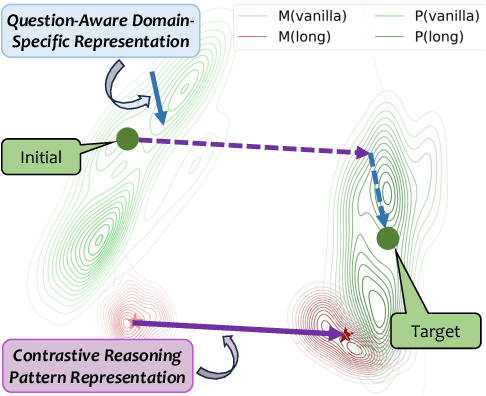



Abstract:Recent advancements in long chain-of-thoughts(long CoTs) have significantly improved the reasoning capabilities of large language models(LLMs). Existing work finds that the capability of long CoT reasoning can be efficiently elicited by tuning on only a few examples and can easily transfer to other tasks. This motivates us to investigate whether long CoT reasoning is a general capability for LLMs. In this work, we conduct an empirical analysis for this question from the perspective of representation. We find that LLMs do encode long CoT reasoning as a general capability, with a clear distinction from vanilla CoTs. Furthermore, domain-specific representations are also required for the effective transfer of long CoT reasoning. Inspired by these findings, we propose GLoRE, a novel representation engineering method to unleash the general long CoT reasoning capabilities of LLMs. Extensive experiments demonstrate the effectiveness and efficiency of GLoRE in both in-domain and cross-domain scenarios.
Have We Designed Generalizable Structural Knowledge Promptings? Systematic Evaluation and Rethinking
Dec 31, 2024Abstract:Large language models (LLMs) have demonstrated exceptional performance in text generation within current NLP research. However, the lack of factual accuracy is still a dark cloud hanging over the LLM skyscraper. Structural knowledge prompting (SKP) is a prominent paradigm to integrate external knowledge into LLMs by incorporating structural representations, achieving state-of-the-art results in many knowledge-intensive tasks. However, existing methods often focus on specific problems, lacking a comprehensive exploration of the generalization and capability boundaries of SKP. This paper aims to evaluate and rethink the generalization capability of the SKP paradigm from four perspectives including Granularity, Transferability, Scalability, and Universality. To provide a thorough evaluation, we introduce a novel multi-granular, multi-level benchmark called SUBARU, consisting of 9 different tasks with varying levels of granularity and difficulty.
Graph Disentangle Causal Model: Enhancing Causal Inference in Networked Observational Data
Dec 05, 2024



Abstract:Estimating individual treatment effects (ITE) from observational data is a critical task across various domains. However, many existing works on ITE estimation overlook the influence of hidden confounders, which remain unobserved at the individual unit level. To address this limitation, researchers have utilized graph neural networks to aggregate neighbors' features to capture the hidden confounders and mitigate confounding bias by minimizing the discrepancy of confounder representations between the treated and control groups. Despite the success of these approaches, practical scenarios often treat all features as confounders and involve substantial differences in feature distributions between the treated and control groups. Confusing the adjustment and confounder and enforcing strict balance on the confounder representations could potentially undermine the effectiveness of outcome prediction. To mitigate this issue, we propose a novel framework called the \textit{Graph Disentangle Causal model} (GDC) to conduct ITE estimation in the network setting. GDC utilizes a causal disentangle module to separate unit features into adjustment and confounder representations. Then we design a graph aggregation module consisting of three distinct graph aggregators to obtain adjustment, confounder, and counterfactual confounder representations. Finally, a causal constraint module is employed to enforce the disentangled representations as true causal factors. The effectiveness of our proposed method is demonstrated by conducting comprehensive experiments on two networked datasets.
PSL: Rethinking and Improving Softmax Loss from Pairwise Perspective for Recommendation
Oct 31, 2024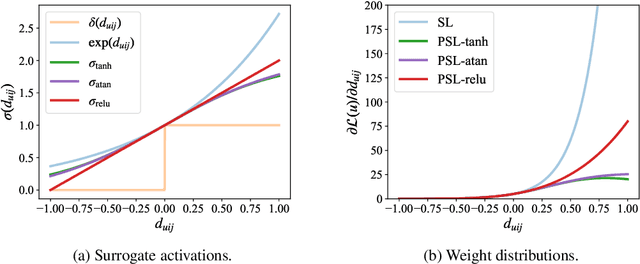
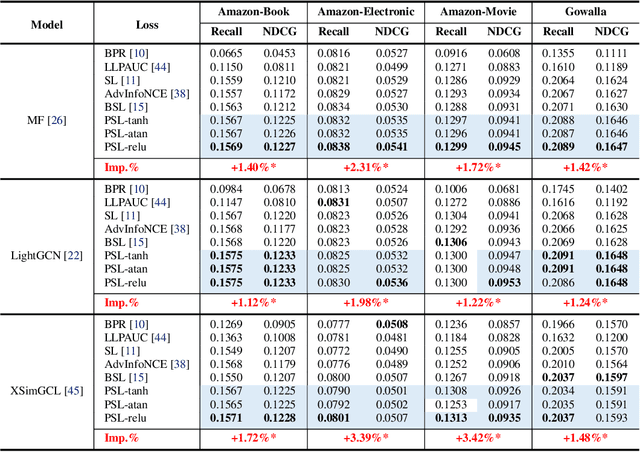
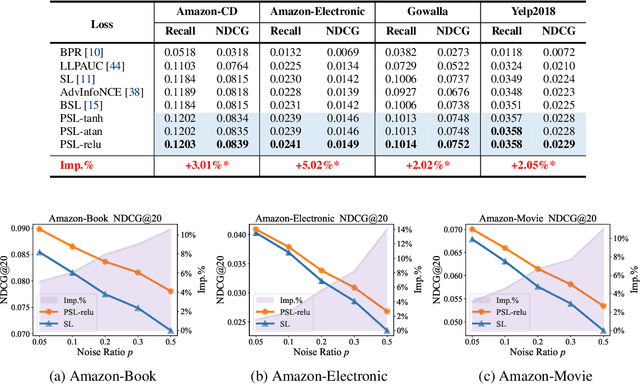

Abstract:Softmax Loss (SL) is widely applied in recommender systems (RS) and has demonstrated effectiveness. This work analyzes SL from a pairwise perspective, revealing two significant limitations: 1) the relationship between SL and conventional ranking metrics like DCG is not sufficiently tight; 2) SL is highly sensitive to false negative instances. Our analysis indicates that these limitations are primarily due to the use of the exponential function. To address these issues, this work extends SL to a new family of loss functions, termed Pairwise Softmax Loss (PSL), which replaces the exponential function in SL with other appropriate activation functions. While the revision is minimal, we highlight three merits of PSL: 1) it serves as a tighter surrogate for DCG with suitable activation functions; 2) it better balances data contributions; and 3) it acts as a specific BPR loss enhanced by Distributionally Robust Optimization (DRO). We further validate the effectiveness and robustness of PSL through empirical experiments. The code is available at https://github.com/Tiny-Snow/IR-Benchmark.
The Devil is in the Sources! Knowledge Enhanced Cross-Domain Recommendation in an Information Bottleneck Perspective
Sep 29, 2024



Abstract:Cross-domain Recommendation (CDR) aims to alleviate the data sparsity and the cold-start problems in traditional recommender systems by leveraging knowledge from an informative source domain. However, previously proposed CDR models pursue an imprudent assumption that the entire information from the source domain is equally contributed to the target domain, neglecting the evil part that is completely irrelevant to users' intrinsic interest. To address this concern, in this paper, we propose a novel knowledge enhanced cross-domain recommendation framework named CoTrans, which remolds the core procedures of CDR models with: Compression on the knowledge from the source domain and Transfer of the purity to the target domain. Specifically, following the theory of Graph Information Bottleneck, CoTrans first compresses the source behaviors with the perception of information from the target domain. Then to preserve all the important information for the CDR task, the feedback signals from both domains are utilized to promote the effectiveness of the transfer procedure. Additionally, a knowledge-enhanced encoder is employed to narrow gaps caused by the non-overlapped items across separate domains. Comprehensive experiments on three widely used cross-domain datasets demonstrate that CoTrans significantly outperforms both single-domain and state-of-the-art cross-domain recommendation approaches.
MSDet: Receptive Field Enhanced Multiscale Detection for Tiny Pulmonary Nodule
Sep 21, 2024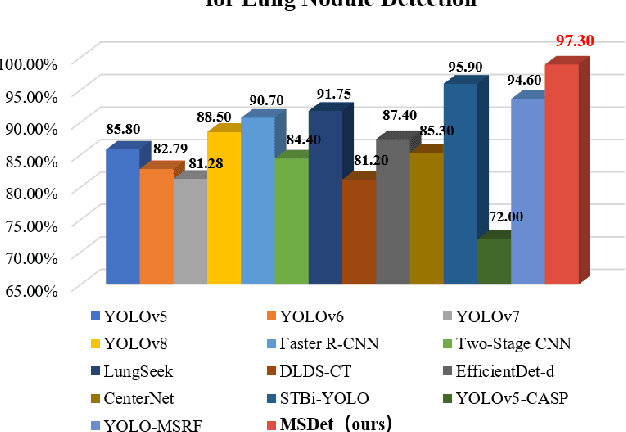
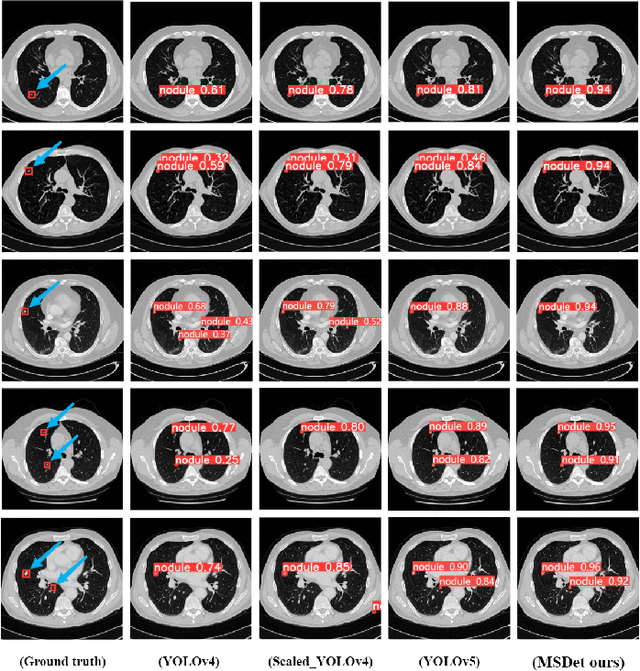
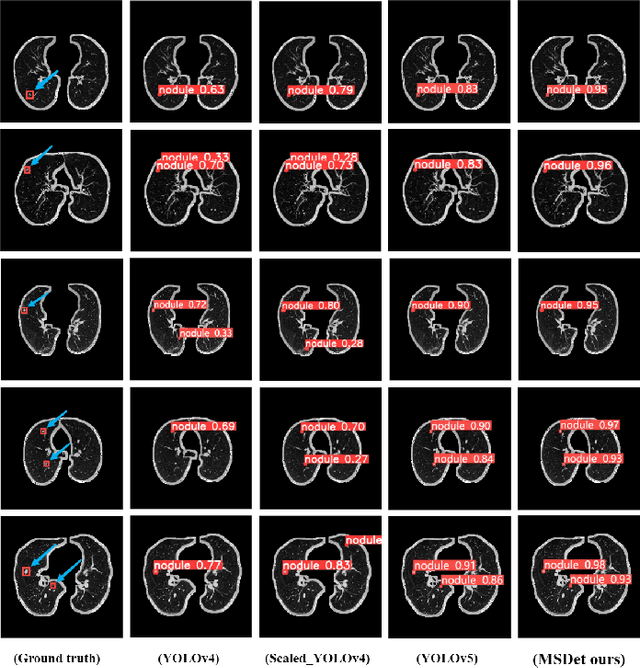
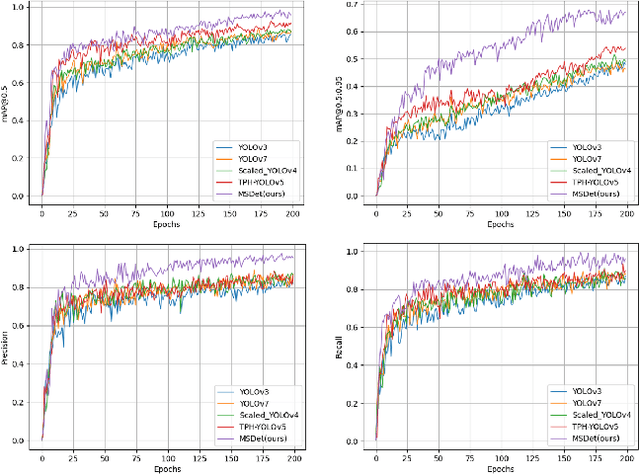
Abstract:Pulmonary nodules are critical indicators for the early diagnosis of lung cancer, making their detection essential for timely treatment. However, traditional CT imaging methods suffered from cumbersome procedures, low detection rates, and poor localization accuracy. The subtle differences between pulmonary nodules and surrounding tissues in complex lung CT images, combined with repeated downsampling in feature extraction networks, often lead to missed or false detections of small nodules. Existing methods such as FPN, with its fixed feature fusion and limited receptive field, struggle to effectively overcome these issues. To address these challenges, our paper proposed three key contributions: Firstly, we proposed MSDet, a multiscale attention and receptive field network for detecting tiny pulmonary nodules. Secondly, we proposed the extended receptive domain (ERD) strategy to capture richer contextual information and reduce false positives caused by nodule occlusion. We also proposed the position channel attention mechanism (PCAM) to optimize feature learning and reduce multiscale detection errors, and designed the tiny object detection block (TODB) to enhance the detection of tiny nodules. Lastly, we conducted thorough experiments on the public LUNA16 dataset, achieving state-of-the-art performance, with an mAP improvement of 8.8% over the previous state-of-the-art method YOLOv8. These advancements significantly boosted detection accuracy and reliability, providing a more effective solution for early lung cancer diagnosis. The code will be available at https://github.com/CaiGuoHui123/MSDet
SegStitch: Multidimensional Transformer for Robust and Efficient Medical Imaging Segmentation
Aug 01, 2024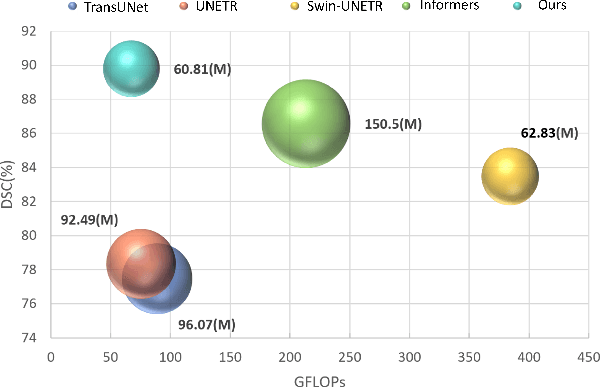

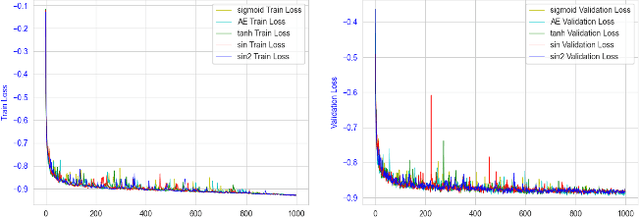
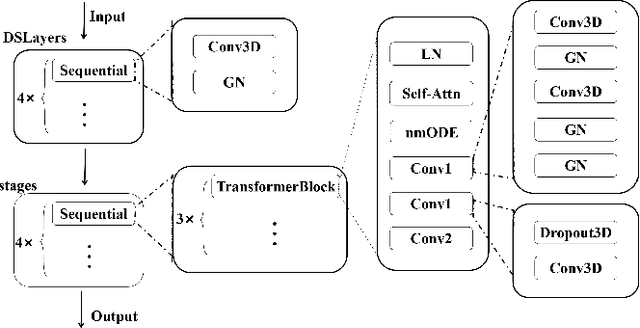
Abstract:Medical imaging segmentation plays a significant role in the automatic recognition and analysis of lesions. State-of-the-art methods, particularly those utilizing transformers, have been prominently adopted in 3D semantic segmentation due to their superior performance in scalability and generalizability. However, plain vision transformers encounter challenges due to their neglect of local features and their high computational complexity. To address these challenges, we introduce three key contributions: Firstly, we proposed SegStitch, an innovative architecture that integrates transformers with denoising ODE blocks. Instead of taking whole 3D volumes as inputs, we adapt axial patches and customize patch-wise queries to ensure semantic consistency. Additionally, we conducted extensive experiments on the BTCV and ACDC datasets, achieving improvements up to 11.48% and 6.71% respectively in mDSC, compared to state-of-the-art methods. Lastly, our proposed method demonstrates outstanding efficiency, reducing the number of parameters by 36.7% and the number of FLOPS by 10.7% compared to UNETR. This advancement holds promising potential for adapting our method to real-world clinical practice. The code will be available at https://github.com/goblin327/SegStitch
Optimizing Long-tailed Link Prediction in Graph Neural Networks through Structure Representation Enhancement
Jul 30, 2024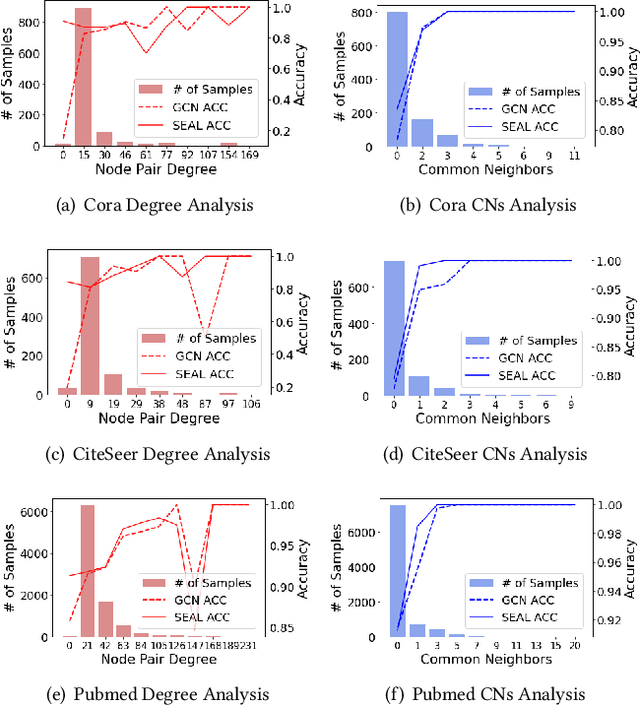



Abstract:Link prediction, as a fundamental task for graph neural networks (GNNs), has boasted significant progress in varied domains. Its success is typically influenced by the expressive power of node representation, but recent developments reveal the inferior performance of low-degree nodes owing to their sparse neighbor connections, known as the degree-based long-tailed problem. Will the degree-based long-tailed distribution similarly constrain the efficacy of GNNs on link prediction? Unexpectedly, our study reveals that only a mild correlation exists between node degree and predictive accuracy, and more importantly, the number of common neighbors between node pairs exhibits a strong correlation with accuracy. Considering node pairs with less common neighbors, i.e., tail node pairs, make up a substantial fraction of the dataset but achieve worse performance, we propose that link prediction also faces the long-tailed problem. Therefore, link prediction of GNNs is greatly hindered by the tail node pairs. After knowing the weakness of link prediction, a natural question is how can we eliminate the negative effects of the skewed long-tailed distribution on common neighbors so as to improve the performance of link prediction? Towards this end, we introduce our long-tailed framework (LTLP), which is designed to enhance the performance of tail node pairs on link prediction by increasing common neighbors. Two key modules in LTLP respectively supplement high-quality edges for tail node pairs and enforce representational alignment between head and tail node pairs within the same category, thereby improving the performance of tail node pairs.
 Add to Chrome
Add to Chrome Add to Firefox
Add to Firefox Add to Edge
Add to Edge